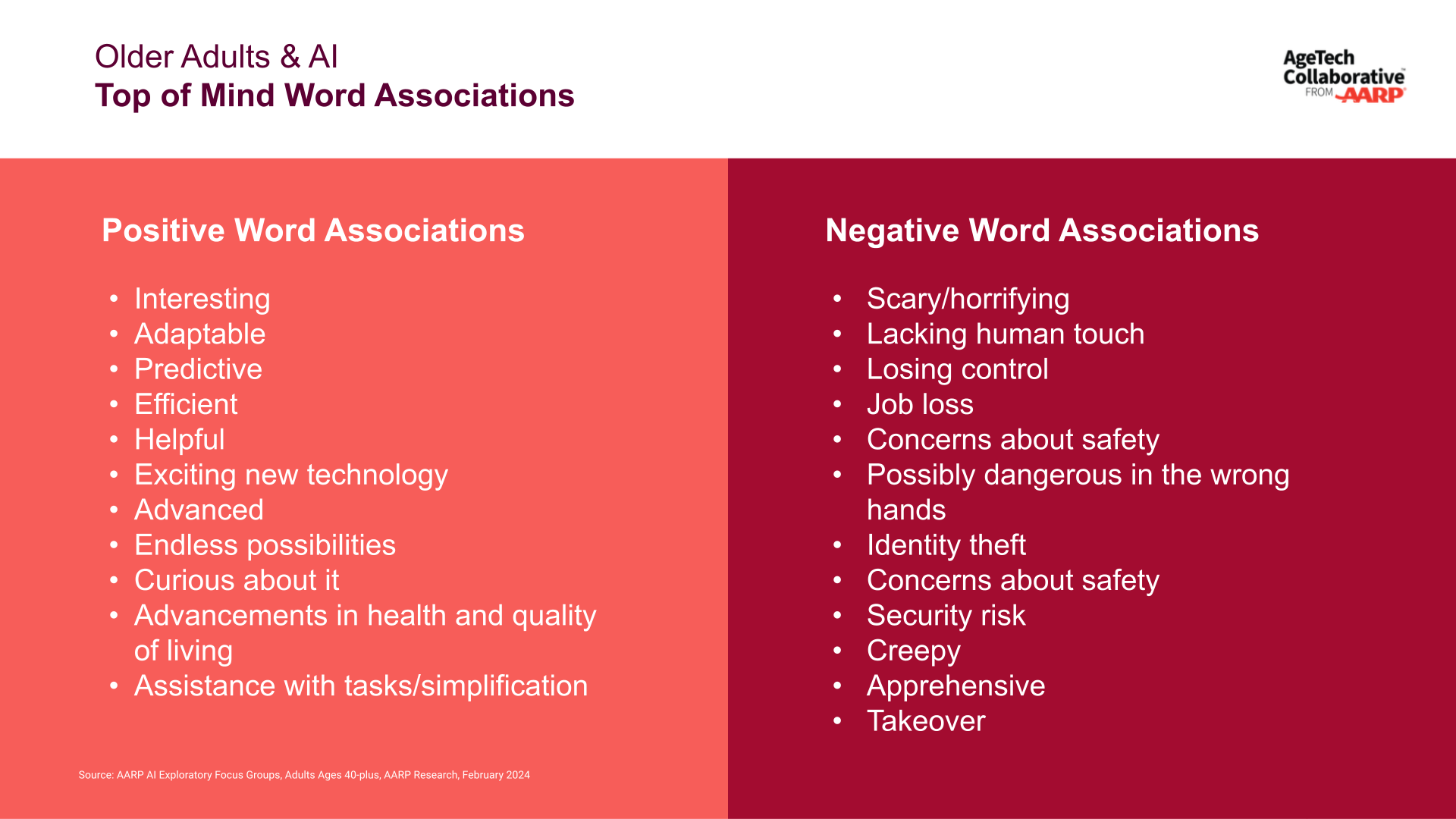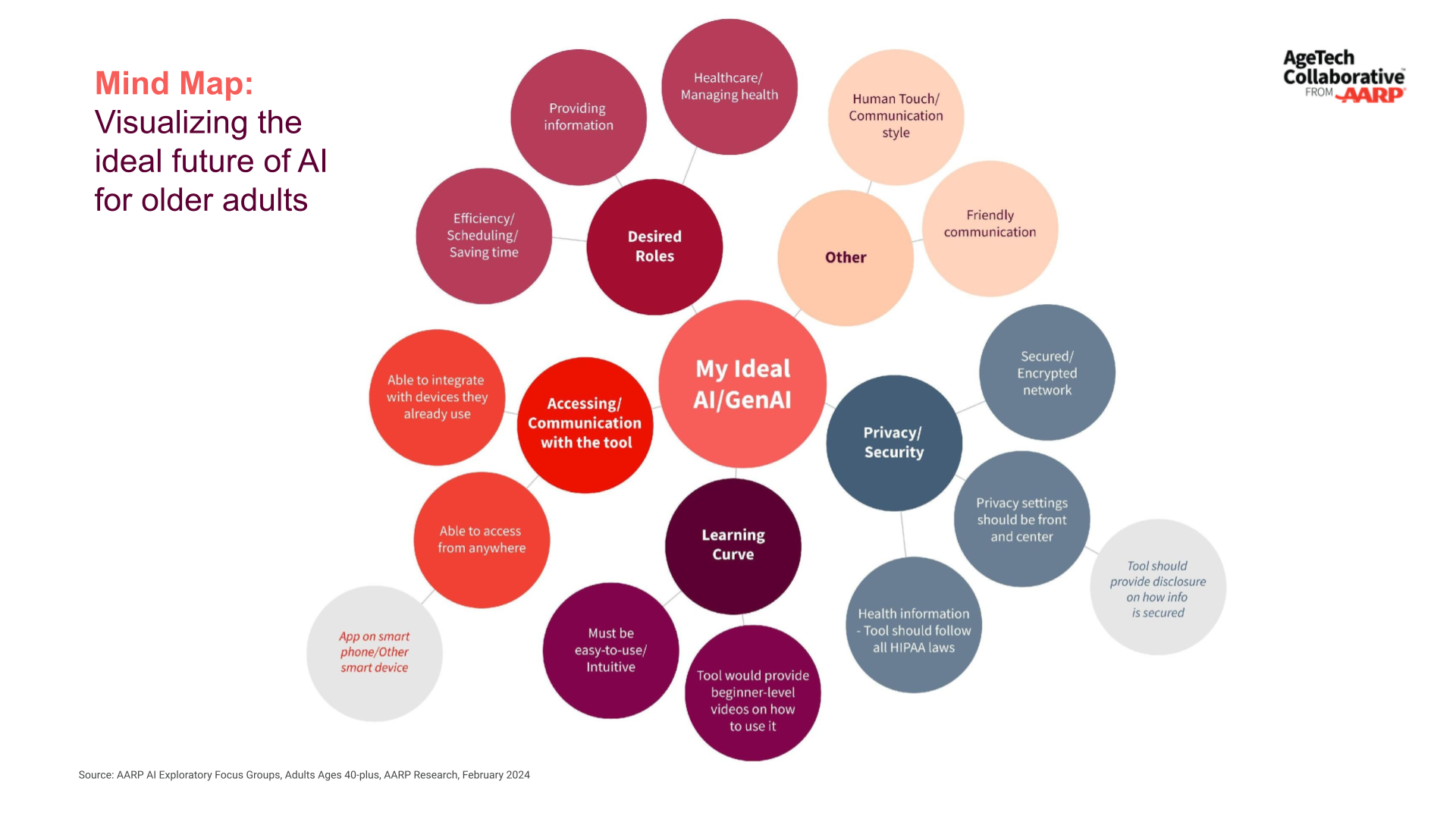Older Adults & AI: Perceptions, Concerns and Potential
By Deborah Jordan and Mrunal Aras
February 2025
About the Study:
To better understand older adults’ perceptions around AI and Generative AI (AKA “GenAI”), a type of AI that uses machine learning to create new content like text, images, videos, and music, AgeTech Collaborative™ from AARP in concert with AARP Research conducted four 90-minute online focus groups. The focus groups had participants segmented by age, level of familiarity and experience with AI. The groups were:
- AI savvy individuals (aged 40-49) — these respondents had used or were familiar with AI or Gen AI
- AI savvy individuals (aged 50-65)
- Less AI savvy individuals (aged 40-49) — these respondents had little to no familiarity and experience with AI or Gen AI
- Less AI savvy individuals (aged 50-65).
AI Is Here to Stay with the Potential to Improve the Lives of Older Adults
We are living in a new era of innovation, one in which artificial intelligence, or AI, plays a pivotal role. AI is a major disruptor of the tech industry—the first since the arrival of smart speakers and voice in 2014—and it has already transformed the way business is done by both automating processes and offering predictive insights.
One age group that has a lot to gain from artificial intelligence are older adults. AgeTech startups are leveraging AI for solutions aimed at improving health and wellness, emotional support, communication, and socializing.
But just because AI has the power to positively impact peoples’ lives as they age in a myriad of ways doesn’t mean they’re embracing it. To better understand older adults’ perceptions around AI and Generative AI, AgeTech Collaborative from AARP in concert with AARP Research conducted four 90-minute online focus groups with a cross section of older adults aged 40-plus. Learnings from these groups showed that perceptions tended to range from negative to mixed, with few overwhelmingly positive. There were many concerns around regulation, AI’s impact on human interactions, and protecting private information while using these tools.
Below, we delve more into these perceptions, and what can be done so that more individuals see the promise of AI to help improve their daily lives.
What Are Older Adults’ Perceptions Around AI?
When focus group participants were asked for their perceptions of AI, they tended to range from negative to mixed, with few overwhelmingly positive. Their descriptions of the disruptive technology ran the gamut from a “confusing and an amorphous, overwhelming concept” to “a double-edged sword.”
A participant elaborated, explaining that “it’s both good and bad, it’s fascinating and scary, it’s exciting and concerning, it’s confusing yet beneficial, it simplifies some things while complicating others.”
One key finding was that participants generally do not understand the difference between AI and GenAI, so they use the terms interchangeably. While some participants said they were familiar with the terms, they were unsure what counts as AI and what doesn’t. “I’m not certain,” said one, “but I think what it is trying to do is replicate human abilities, the way humans speak, the way they act, the way they interact. So, it’s a replication of human behavior, kind of.”
What Are Older Adults’ Biggest Concerns Around AI?
The focus group participants’ biggest concerns around AI range from privacy and fraud concerns, and the lack of regulation to losing “human touch” from interactions and communication and the price barrier for many.
A recent AARP study conducted to understand the concerns of U.S. adults ages 50 and older regarding the potential misuse of AI for identity theft and fraud found a significant level of worry about the various ways AI can be used fraudulently to get people to share confidential information or make financial transactions.
A participant expressed their feelings by saying they have “no say and no representation. Nobody’s standing up for us.” Another voiced concerns about AI leading to a lack of creativity and innovation.
There’s also a perception that AI is just not useful for them, as compared to their children or grandchildren. Some spoke about their negative past experiences, when they tried using an AI tool, it did not pick up on their humor or understand the nuances of their communication. This turned them off of trying to use it again. And, finally, some simply did not perceive AI to be useful in their particular line of work.
When asked, some top of mind negative word associations that the participants mentioned were “scary,” “safety and security risk,” “creepy,” “loss of control,” and a few more.
What Are Older Adults Excited about When It Comes to AI?
Despite their concerns and hesitations, the participants do see potential good in AI. For instance, they suggested some ways they could see themselves using GenAI – planning workouts, creative brainstorming for their art, writing a holiday letter, drafting business proposals, etc. However, most said that they aren’t knowingly using it at the present time.
The participants did express some concrete reasons that they’re excited about AI. When asked, some top of mind positive word associations that the participants mentioned were “interesting,” “advanced,” “adaptable,” and “exciting” — in other words, they saw the potential AI has to make their lives easier and more safe as they age. They specifically mentioned its long-term potential to improve health outcomes, simplify life’s everyday tasks, making things easier for their children and their grandchildren, and increase overall productivity and efficiency. One of the participants spoke about how with every new technology, we never know how far it can go.
“I remember the first cell phones; they were for only phone calls and texting. Look at what we’re doing with them now and how they’ve changed and enhanced our lives. We really are at the beginning of this technology, and who knows how far it’s going to take us… There are huge possibilities here.”

Key Applications of AI for Older Adults: Top Perceived Uses
When asked how they believe people or businesses are using AI, participants often mention that they have seen businesses using AI for customer service (e.g. chatbots) purposes. For example, participants share that when engaging with their energy or internet service provider, they often must chat with a bot or speak with an AI tool. These act as a “filter” for customer service requests to direct them to the right department or solve their problem without having to speak with a customer service rep.
Participants also mention the following uses of AI by people or businesses:
- In Healthcare: “The biggest need that I see in my life today for AI is in the healthcare space,” says a focus group participant. “So, I would want it to be able to proactively monitor my health and suggest diagnostic procedures that may likely be needed.” Medical diagnostics, predicting future health issues, tracking vaccination statuses over time, assisting with analyzing medical imaging, robotics used in surgery, implants to improve physical functioning (e.g., placing a chip in the brain that helps a physically disabled person achieve greater functionality).
- In Finance: Predicting investments, optimizing stock market investments.
- In Advertising/Marketing: Creating more targeted advertisements, developing creative (e.g., book covers, graphic designs, etc.).
What Older Adults Want from AI
Focus group participants expressed that they are envisioning a future where AI and GenAI addresses their unique needs and preferences. They articulated a forward-looking vision for how AI could integrate seamlessly into their daily routines, offering solutions that are not just functional but genuinely meaningful.
There are a number of ways seniors see themselves using AI, both now and in the future, which will include:
- As an assistant – Managing tasks and to-dos. One participant said she would use AI to help filter through recipes and find ones to cook. “It could help me do meal-planning for a week so I could make one trip to the market instead of five.”
- Managing health – Analyzing health records; managing nutritional needs; helping them connect with doctors, etc. One participant believes AI also has the potential to improve the healthcare system in this country. “The system is so fragmented and broken. A good use of AI would be to improve the healthcare that we receive.”
- Simplicity and ease-of-use – No learning curve; start using it immediately, or be able to view easy-to-follow videos. One participant’s wishlist included the following: “an app that will open on any device (smartphone, laptop, etc.); easy to log in; data not sold or tracked; and a tutorial in the app.”
- A personal touch – Understand their preferences, possess human-like characteristics (friendly, sense of humor, etc.).

Key Takeaways
Overall, research participants were familiar with the term AI, but had a limited knowledge about it and what qualifies as AI. Many said they did not use AI/GenAI, not due to a lack of interest, but rather a lack of knowledge.
Their perceptions were mixed, but the majority view AI/Gen AI as a double-edged sword. They have reason to be excited about its potential to improve health outcomes, simplify their lives, allow them to live independently for longer, and increase productivity. However, they have concerns around regulatory aspects of its use, privacy, and the loss of “human touch” from interactions.
In order for older adults to feel comfortable using AI, both now and in the future, steps need to be taken to ensure that AI technologies are safe, accessible, and aligned with the best interests of the aging population. Companies that would like to leverage AI in their products and services should consider the following guidance from AARP’s policy book:
- Collaborative efforts between AI developers, healthcare professionals, and policymakers are essential to ensure that these technologies are safe, accessible, and aligned with the best interests of our aging population.
- Transparent communication about how AI is being used and the benefits it provides is essential to foster trust between seniors, caregivers, and technology developers.
- Building trust through robust privacy and security measures that empower consumers with control over their personal data and ensure heightened protections for sensitive information.
- Meaningful accountability ensuring that entities maintain comprehensive documentation and data to enable a thorough review of algorithmic decisions allowing consumers to understand and challenge AI-enabled decisions.
In spite of the view of AI/Gen AI as a double-edged sword, the excitement about AI’s potential impact on aging is expected to keep AI at the forefront of solutions for older adults. However, without protections, mixed or negative perceptions of AI could continue to cloud older individuals’ views on the potential these technologies hold to help them age with dignity and confidence.
